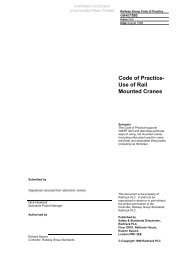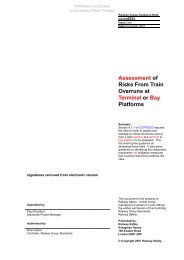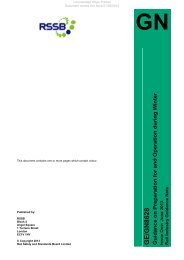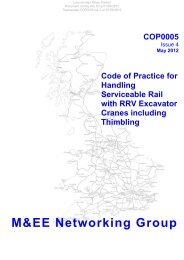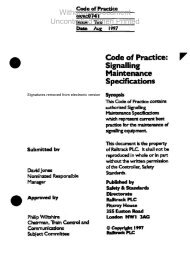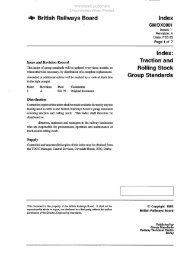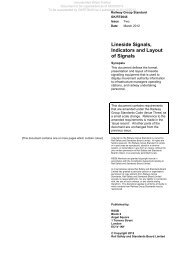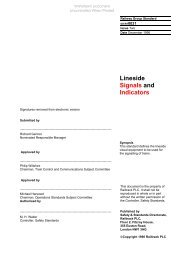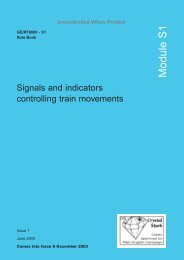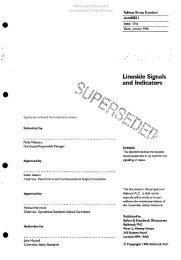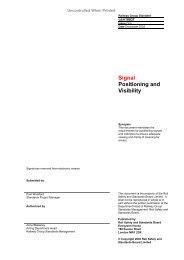General Information on Track Circuits - RGS Online
General Information on Track Circuits - RGS Online
General Information on Track Circuits - RGS Online
Create successful ePaper yourself
Turn your PDF publications into a flip-book with our unique Google optimized e-Paper software.
Railway Group Approved Code of Practice<br />
GK/RC0752<br />
Issue Two<br />
Date December 1998<br />
Page D14 of 20<br />
<str<strong>on</strong>g>General</str<strong>on</strong>g> <str<strong>on</strong>g>Informati<strong>on</strong></str<strong>on</strong>g> <strong>on</strong> <strong>Track</strong> <strong>Circuits</strong><br />
Only One B<strong>on</strong>ded Fishplate Joint Permitted<br />
13 METRES MAX.<br />
If X Or Y >13m Then Additi<strong>on</strong>al Cross B<strong>on</strong>ds To The Stock Rails Will Be Required<br />
Figure D9<br />
D14 RAILTRACK<br />
Y<br />
X<br />
13.5 Series B<strong>on</strong>ding Simplificati<strong>on</strong><br />
If series b<strong>on</strong>ding becomes complex, it imposes penalties <strong>on</strong> both reliability and<br />
maintenance. The opti<strong>on</strong> of cut secti<strong>on</strong>s should then be c<strong>on</strong>sidered. A<br />
maximum of four point ends or fifteen IRJs (including boundary joints) per track<br />
circuit is str<strong>on</strong>gly recommended.<br />
13.6 Applicati<strong>on</strong>s of B<strong>on</strong>ding C<strong>on</strong>figurati<strong>on</strong>s<br />
Type of<br />
<strong>Track</strong><br />
N<strong>on</strong>–electrified<br />
Lines<br />
A.C. Electrified<br />
Lines<br />
D.C. Electrified<br />
Lines<br />
Plain Line DRDS or CR DRDS or SR DRDS or SR♣<br />
S & C DRSS * SR SR<br />
Complex<br />
S & C<br />
Figure D10<br />
Notes:<br />
Withdrawn Document<br />
Unc<strong>on</strong>trolled When Printed<br />
CR # SR SR<br />
* Where DRDS is impracticable.<br />
# Where DRDS and DRSS are impracticable.<br />
♣ Maximum permitted length is 200m.<br />
13.7 IRJs Between Differing <strong>Track</strong> Circuit Types<br />
IRJs must be provided in both running rails at the point where differing track<br />
circuit types abut. Special cases will be discussed in the relevant secti<strong>on</strong>s.<br />
13.8 IRJs at Signals<br />
Where a signal is replaced to danger by occupati<strong>on</strong> of the first track circuit<br />
ahead, the IRJs will generally be positi<strong>on</strong>ed between 5m - 20m bey<strong>on</strong>d the<br />
signal. For further informati<strong>on</strong> see SSP 62.<br />
13.9 Jointed <strong>Track</strong> <strong>Circuits</strong> Abutting N<strong>on</strong>–track Circuited Line<br />
In order to detect defective IRJs where a jointed track circuit adjoins a n<strong>on</strong>–track<br />
circuited secti<strong>on</strong>, a short circuit b<strong>on</strong>d must be provided immediately bey<strong>on</strong>d the<br />
IRJs, as shown in Figure D11. This b<strong>on</strong>d shall be a standard b<strong>on</strong>d <strong>on</strong> n<strong>on</strong>–<br />
electrified lines, or a tracti<strong>on</strong> standard b<strong>on</strong>d <strong>on</strong> electrified lines.



